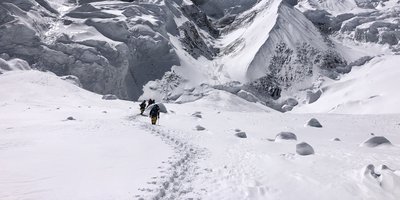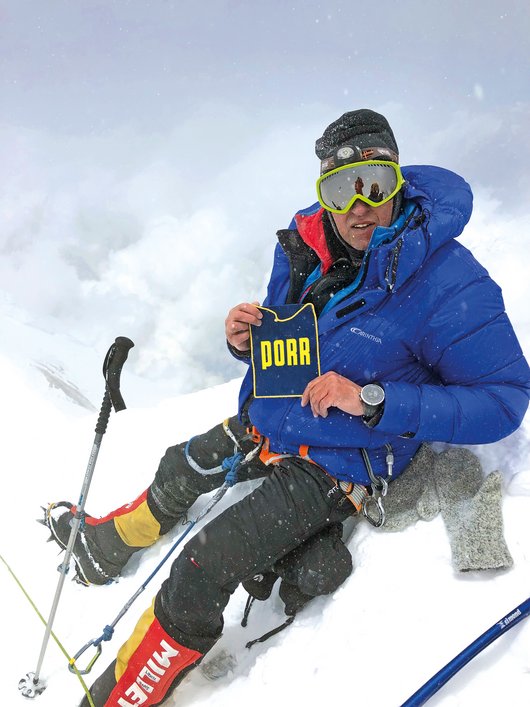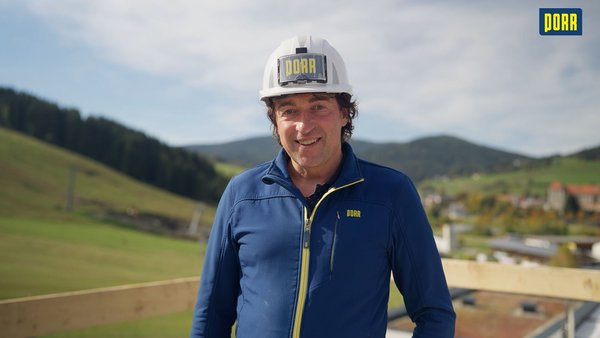![[Translate to Englisch:] (c) PORR [Translate to Englisch:] (c) PORR](/fileadmin/_processed_/3/3/csm_5V5A3742_4c8554371e.jpg)

Lord of the Mountains
Four more to go. Then he’ll have been on top of all the highest summits in the world. Hans Wenzl has already conquered ten of the 14 eight-thousanders. His tenth success was Annapurna – at 8,091m, a rather low and lesser-known, infrequently scaled eight-thousand-metre peak. Nonetheless, this mountain is the most dangerous in the world, with a 41% fatality rate – the ratio of successful climbs to fatalities. Here, Hans gives us his expedition report.
The lowest base camp and important acclimatisation
Our expedition set out on 23 March. After a two-day stay in Kathmandu, the capital of Nepal, we embarked on our journey to the base camp, which we reached after four days. We were an international team with eleven mountaineers from several different countries and six Sherpas from Nepal. There were 25 mountaineers in total at the base camp on Annapurna. Compared to the other eight-thousanders, that is not many at all. Mount Everest, for example, sees around 400 to 600 mountaineers every year. At an altitude of 4,200m, the base camp is the lowest of all the eight-thousanders. This altitude provides good conditions for your body to recover after the nights spent in high-altitude camps.
Before climbing an eight-thousand-metre peak without supplemental oxygen, it is best to spend about three weeks allowing your body to adapt to the altitude, also known as acclimatisation. This means climbing up to the highaltitude camps to spend one or two nights there, and then heading down again to the base camp to recover physically. The main disadvantage of Annapurna is that safe acclimatisation is only possible up to Camp 2 at around 5,500m. Beyond this point, there is a very high risk of avalanches, with new snow avalanches and serac break-offs occurring on a daily basis
First attempt and second chance
On 16 April, highly motivated and with a good weather forecast, we ascended to Camp 2 at 5,500m. That afternoon, however, the weather took a sudden turn for the worse. There was heavy snowfall, a band of cloud lingered around the mountain, and almost a metre of fresh snow had fallen by the evening. In the end, we had to abandon the ascent to the summit. Continuing the ascent the next day would have been impossible and life-threateningly dangerous. So we had no choice but to descend back to base camp and wait. There were a lot of avalanches over the next few days.
Finally, on 25 April, conditions improved again. The next day we left Camp 2 and climbed a dangerous avalanche slope to Camp 3 at 6,300m. It was a freezing cold, sleepless night. We kept hearing avalanches crashing down nearby. On 27 April we made the ascent to Camp 4 at 6,950m, where we arrived in the late afternoon, completely exhausted. We then had to make sure that everything was ready for the ascent to the summit the next day
Spectacular summit success and dark descent
It was around 1:30 am – later than planned because of the fierce wind – that I and two teammates set out from Camp 4 for the summit. With a high wind and temperatures below –30ºC, every metre is a challenge. Obviously, climbing an eight-thousand-metre peak is much more difficult if you’re not using supplemental oxygen. I struggled upwards metre by metre until finally, at 12:30 pm, I arrived at the highest point of Annapurna at 8,091m.
The weather was getting progressively worse. I spent barely 15 minutes at the summit to ensure that I could descend safely. After that I set off on the long hike back to Camp 4. On the way down I met my two teammates who were still ascending at that very late hour.
Thunderstorms, heavy snow, and fog. If I hadn’t had my hand on the fixed rope, it would have been impossible for me to find my way back. At around 5 pm I finally reached my tent. I was safe. I arrived back at base camp on 29 April at 4 pm. My two teammates didn’t make the descent to Camp 4 in time after ascending to the summit due to poor visibility and had to spend the night outdoors. They had to be rescued from 6,900m by helicopter, suffering from severe frostbite.
You don’t really experience that feeling of pure bliss until you have safely reached base camp. However, memories of the tough times stay with you for years to come. Will I ascend the other four summits? I haven’t decided yet. Right now, I am enjoying reliving the wonderful impressions and the amazing experiences of the Annapurna expedition.




![[Translate to Englisch:] (c) PORR [Translate to Englisch:] (c) PORR](/fileadmin/_processed_/1/f/csm_220715_Lower_Silesian_Sport_Center__2__3bef20ac63.jpg)
